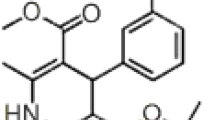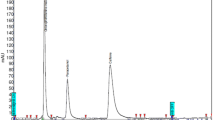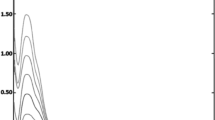Abstract
A rapid and sensitive reverse-phase high performance liquid chromatography (RP–HPLC) method with ultra-violet (UV) detection for a routine control of hydrochlorothiazide and captopril in tablets was developed. The chromatographic system Hewlet Packard 1100 consisted of a HP 1100 pump, HP 1100 UV–VIS detector and HP ChemStation integrator. The samples were introduced through a Rheodyne injector valve with a 20-μL sample loop. The isocratic system consisted of a Beckman Ultrasphere ODS 4.6 mm x 15 cm, 5-μm-particle column and a mobile phase containing methanol/water (45:55 v/v). The pH of the mobile phase was adjusted to 3.8 with 85% ortophosphoric acid. Quantitation was accomplished using the internal standard method. At the selected conditions, the other excipients of the tablets did not interfere in the assay of active substances. The developed RP–HPLC method was validated, so linearity, precision, accuracy, robustness, limit of quantitation and limit of detection were investigated. For the robustness test, three factors were considered: the composition of the mobile phase , the pH of the mobile phase, and temperature. With the aid of response surface metodology (RSM), it was possible to precisely define the robustness of the method.
Similar content being viewed by others
Explore related subjects
Discover the latest articles, news and stories from top researchers in related subjects.Avoid common mistakes on your manuscript.
Introduction
In this paper a reversed-phase high performance liquid chromatography (RP–HPLC) method for assaying Catopil plus tablets (Galenika a.d., Belgrade, Yugoslavia) is described. Two samples of Catopil plus tablets were examined: sample 1 which contained 50 mg of captopril and 25 mg of hydrochlorothiazide and sample 2 containing 25 mg of captopril and 12.5 mg of hydrochlorothiazide. Hydrochlorothiazide (6-chlor-7-sulfamoyl-3,4-dihydro-2H-1,2,4-benzo-thiadiazine-1,1-dioxide) is a sulfonamide diuretic. Hydrothiazides and related drugs enhance excretion of sodium, chloride, and water by interfering with the transport of sodium ions across the renal tubular epithelium. They are antihypertensive and augment the action of other hypotensive drugs. Captopril ((S)-1-(3-mercapto-2-methyl-propionyl)-l-proline) is an angiotenzine-converting enzyme (ACE, bradykinase, kininase II) inhibitor. It differs from other ACE inhibitors by the presence of a sulfhydrile group. Captopril is characterized by the lack of a strong chromophore and is, therefore, unable to absorb at higher wavelengths. The main objective of this study was to develop and validate an RP–HPLC method for the simultaneous determination of hydrochlorothiazide and captopril in tablets.
For the qualitative and quantitative analysis of captopril and hydrochlorothiazide the RP–HPLC method was used with a mobile phase of methanol and sodium dihydrogenphosphate [1]. Captopril and hydrochlorothiazide, and their degradation products were analyzed by HPLC with gradient elution [2]. Separation of captopril diastereoisomers was performed by the RP–HPLC method, using a column with a specially modified chiral stationary phase [3]. In biological fluids, captopril and hydrochlorothiazide were determined using thin layer chromatography (TLC) [4, 5, 6], gas chromatography (GC) [7, 8, 9] and capillary electrophoresis (CE) [10].
Establishing the most appropriate chromatographic conditions, i.e., the stationary and mobile phase combination, allowed simultaneous determination of hydrochlorothiazide and captopril. The developed method was then subjected to method validation, which meant the investigation of selectivity, linearity, precision, robustness, limit of detection, and limit of quantitation.
Experimental
Materials and reagents
Catopil plus (sample 1: one tablet contains 50 mg of captopril and 25 mg of hydrochlorothiazide; sample 2: one tablet contains 25 mg of captopril and 12.5 mg of hydrochlorothiazide) which is the official formulation of the tablet form of Galenika a.d, Belgrade, Yugoslavia. The standards of hydrochlorothiazide and captopril were obtained from Galenika a.d, Belgrade.
All the chemicals and reagents were of analytical reagent grade. Water was redistilled and filtered through a membrane filter. Methanol—gradient grade (Merck, Darmstadt, Germany) and 85% ortophosphoric acid were used to prepare the mobile phase. The mobile phase was degassed and filtered through nylon membrane filters, 0.45 μm (Whatman, England).
Chromatographic conditions
The chromatographic system Hewlett Packard 1100 consisted of an HP 1100 pump, HP 1100 UV–VIS detector and HP ChemStation integrator. Separations were performed on a Beckman Ultrasphere ODS 4.6 mm x 15 cm, 5-μm-particle column at 40°C. The samples were introduced through a Rheodyne injector valve with a 2- μL-sample loop.
Simultaneous determination of hydrochlorothiazide and captopril was performed by applying the mobile phase which consisted of methanol and water (45:55 V/V). The pH of the mobile phase was adjusted to 3.8 with 85% ortophosphoric acid. The mobile phase was filtered through a 0.45-μm Millipore filter and degassed in an ultrasonic bath. Phenobarbital was used as an internal standard. The flow rate of the mobile phase was 1 ml/min and UV detection was performed at 210 nm.
Standard solutions
Standard solutions for calibration curves were prepared in the following concentration range: hydrochlorothiazide 0.01–0.1 mg/ml and captopril 0.02−0.2 mg/ml.
Laboratory mixtures
Laboratory mixtures which corresponded to Catopil plus tablets were prepared from hydrochlorothiazide (0.03, 0.05 and 0.07 mg/ml) and captopril (0.06, 0.1 and 0.14 mg/ml) in the mobile phase. For chromatographic separation, phenobarbital was added as an internal standard at a concentration of 0.1 mg/ml.
Sample solutions
Ten Catopil plus tablets of sample 1 and sample 2 were weighed and ground. An amount that contained 50 mg of captopril, i.e., 25 mg of hydrochlorothiazide, was weighed and transferred with the mobile phase to a 50-ml volumetric flask. The flask was placed in an ultrasonic bath for 15 min and then the solution was diluted to the mark with the mobile phase. After filtration, 0.6, 1.0, and 1.4 ml were mixed with 1 ml of an internal standard solution in a 10-ml volumetric flask to make the final concentrations of the solution, approximately the same as the laboratory mixture solutions. The resulting solutions were injected into the column.
Results and discussion
The most important aspect of method development in liquid chromatography is the achievement of sufficient resolution within a reasonable analysis time. This goal can be achieved by adjusting accessible chromatography factors to give the desired response. A good chromatographic separation requires capacity factors to be neither too low (tendency of molecules to be in a mobile phase rather than in the stationary phase), nor too high (long analysis time, poor detection sensitivity). Usually, the methods focus on defining an optimal mobile phase composition, i.e., the ratio of water and organic solvents (modifiers). However, varying the pH of the mobile phase may lead to better selectivity. The degree of ionization of solutes, mobile phase additives, and stationary phase may be affected by the pH. In order to allow work at the pH value that yields the best possible selectivity, it is necessary to vary the pH and aqueous/organic ratio simultaneously.
The choice of the method depends on factors such as the nature of the drug, the complexity of the sample, and the intended use. In this study the conditions were influenced by the physical-chemical properties of hydrochlorothiazide and captopril, such as solubility, polarity, UV absorption, and interference. The apparent pKa’s of captopril were 3.7 and 9.8, and of hydrochlorothiazide 7.9 and 9.2 [11]. Captopril, being a thiol, undergoes oxidative degradation, but the maximum stability can be achieved in acidic solutions below pH 4.0 [12].
The influence of the mobile phase composition on the separation of hydrochlorothiazide and captopril was investigated following retention times. It was important to obtain the most appropriate conditions when: a) hydrochlorothiazide and captopril were satisfactory separated, and b) hydrochlorothiazide had an appropriate chromatographic behavior. Changes in the mobile phase strength, by increasing or decreasing the methanol content and varying the mobile phase pH, affected the separation and hydrochlorothiazide chromatographic behavior the most. In order to maintain captopril stability all the solutions were acidic. Hydrochlorothiazide was protonated and its affinity for the stationary phase was very low. By increasing the organic modifier content, the value of the hydrochlorothiazide capacity factor was increased to a certain extent. The separation was not affected significantly by the mobile phase strength, so the best chromatographic conditions primarily concerned the hydrochlorothiazide’s chromatographic behavior.
For the separation and determination of hydrochlorothiazide and captopril in Catopil plus tablets, a Beckman Ultrasphere ODS 4.6 mm x 15 cm, 5-μm-particle size column was used. A mobile phase, containing methanol/water (45:55 V/V) at a pH adjusted to 3.8 with 85% ortophosphoric acid, was the most appropriate. Captopril is characterized by the lack of a strong chromophore, so detection was performed at 210 nm. The flow rate of the mobile phase was 1 ml/min. Figure 1 shows a representative chromatogram of the analyzed Catopil plus tablets with a good separation of hydrochlorothiazide and captopril.
The proposed RP–HPLC method was validated. First, selectivity of the investigated substances towards other excipients in the tablets was investigated, then linearity, precision, robustness, limit of detection, and limit of quantitation.
The selectivity of an analytical method is defined as its ability to measure accurately an analyte in the presence of interferences, such as synthetic precursors, excipients, and known degradation products that may be expected to be present in the sample matrix. By analyzing the chromatograms obtained for the laboratory mixture and pharmaceutical preparation, a good selectivity of the developed RP–HPLC method could be shown.
Linear relationships of the peak area over the mentioned concentration ranges for hydrochlorothiazide and captopril were obtained. The important parameters of calibration curves: slope (a), intercept (b), correlation coefficient (r), standard deviation of the slope (S a ) and standard deviation of the intercept (S b ) are presented in Table 1. Correlation coefficient or Person’s r measures the strength of a linear association between two quantitative variables. The closer r is −1 or +1, the stronger is the linear association, with the sign of r indicating a decreasing (r <0) or an increasing (r >0) linear association. The sample correlation coefficient can only equal +1 (−1) when the observations lie exactly on a straight line having a positive (negative) slope. The limit of detection (LOD) and limit of quantitation (LOQ) were experimentally determined and are also presented in Table 1. The LOD is the lowest concentration of analyte in a sample that can be detected, but not necessarily quantitated, under the stated experimental conditions, while the limit of quantitation is the lowest concentration of analyte in a sample that can be determinated with acceptable precision and accuracy under the stated experimental conditions (USP 24).
The best resolution was obtained using phenobarbital as an internal standard. The concentrations of active ingredients were calculated by the internal standard method.
The precision of the proposed method was investigated and the results are presented in Table 2. The results for standard deviation, coefficient of variation, and statistical parameter t α (experimantal determined values of t α are less than tabelar value of t α , t tab =2.821) show that the described RP–HPLC method is precise and can be used for routine analysis of dosage forms which contain hydrochlorothiazide and captopril.
In Table 3 the results of the RP–HPLC determination of hydrochlorothiazide and captopril in Catopil plus tablets are given. Important statistical values such as standard deviation and coefficient of variation, as well as good recoveries, are shown. The standard deviation and coefficient of variation have a small required value. The recovery values confirm that (Table 3), as USP 24 (Official Monographs, p. 297) requests, captopril and hydrochlorothiazide tablets contain not less than 90.0% and not more than 110% of the labeled amounts of captopril and hydrochlorothiazide.
The robustness of an analytical procedure refers to its capability to remain unaffected by small and deliberate variations in method parameters, i.e., without changes in quantitation. For the determination of a method’s robustness, a number of method parameters, for example, pH, mobile phase composition, column temperature, flow rate, etc., are varied within a realistic range, and the quantitative influence of the variables is determined.
Three factors (parameters) were selected from the analytical procedure to be examined in the robustness testing: mobile phase composition, pH of the mobile phase, and column temperature. The capacity factor values for hydrochlorothiazide and captopril were the responses which were followed. A response surface method was carried out to obtain more information and to investigate the behavior of the response around the nominal values of the factors. Response surface methodology (RSM) has the following advantages: a) it allows a complete study where all interaction effects are estimated; b) it gives an accurate description of an experimental region around the center of interest with validity of interpolation [13, 14]. Generally, a large number of experiments are required by standard design applied in RSM, but in that way it is possible to anticipate to a certain degree and precisely define the robustness of the method.
The effects of selected factors were examined in the range of conditions where they had provided acceptable retention and resolution. The tests were carried out with the ratio of methanol content from 30% to 65%, pH range from 2.5 to 5.0, and temperature range from 20°C to 55°C. For each experiment, capacity factor values for hydrochlorothiazide and captopril were determined. The three-dimensional (3-D) graphs, constructed with 64 experimental points, were used in the robustness test considerations.
The 3-D graphs representing kH=f (% M, pH) and kK=f (% M, pH) are given in Figs. 2 and 3. The 3-D graphs representing kH=f (% M, t°C) and kK=f (% M, t°C) are given in Figs. 4 and 5.
The mobile phase composition normally affected chromatographic behavior of the investigated substances the most. Considering the physical-chemical characteristics of hydrochlorothiazide and captopril (apparent pKa‘s), the influence of pH of the mobile phase should be expected. However, experimental data had shown that at the ratio of methanol content from 30% to 50%, the influence of the pH of the mobile phase could be neglected. Column temperature had a minor influence, so the assay could be considered robust because none of the studied factors had a significant effect on the determination of the content of hydrochlorothiazide and captopril in tablets.
The developed method is rapid, accurate, sensitive, and the results are reproducible. The authors propose this method for the separation, identification, and simultaneous determination of pharmaceutical dosage forms which contain hydrochlorotihzide and captoprile.
References
Jain R, Jain CL (1991) Indian Drugs 28(8):380–382
Kirschbaum J, Perlman S (1984) J Pharm Sci 73(5):686–687
Owens PK, Svensson LA, Vessman J (2001) J Pharm Biomed Anal 25(3−4):453–464
Ling BL, Baeyens WRG, Del Castillo B, Imai K, De Moerloose P, Stragier K (1989) J Pharm Biomed Anal 7(12):1663–1670
Ling BL, Baeyens WRG, Del Castillo B, Stragier K, Marysael H, De Moerloose P (1989) J Pharm Biomed Anal 7(12):1671–1678
Ling BL, Baeyens WRG, Marysael H, Stragier K, De Moerloose P (1989) J Liq Chromatogr 12(16):3135–3149
Ito T, Matsuni Y, Kurihara H, Nambara T (1987) J Chromatogr 417(1):79–87
Liu YC, Wu HL, Kou HS, Chen SH, Wu SM (1995) Anal Lett 28 (8):1465–1481
Carreras D, Imaz C, Navajas R, Garcia MA, Rodriguez C, Rodriguez A, Cortes R (1994) J Chromatogr 683 (1):195–202
Hillaert S, De Grauwe K, Van der Bossche W (2001) J Chromatogr A 924(1−2):439–449
Dollery C (1999) Therapeutic Drugs, Churchill Livingstone, Edinburgh
Connors KA, Amidon GL, Stella VJ (1986) Chemical Stability of Pharmaceuticals in: A Handbook for Pharmacists. Second Edition, A Wiley–Interscience Publication, New York.
Fabre H (1996) J Pharm Biomed Anal 14:1125–1132
Regonese R, Mulholland M, Kalman J (2000) J Chromatogr A 870:45–51
Author information
Authors and Affiliations
Corresponding author
Rights and permissions
About this article
Cite this article
Ivanovic, D., Medenica, M., Malenovic, A. et al. Validation of the RP–HPLC method for analysis of hydrochlorothiazide and captopril in tablets. Accred Qual Assur 9, 76–81 (2004). https://doi.org/10.1007/s00769-003-0722-9
Received:
Accepted:
Published:
Issue Date:
DOI: https://doi.org/10.1007/s00769-003-0722-9









